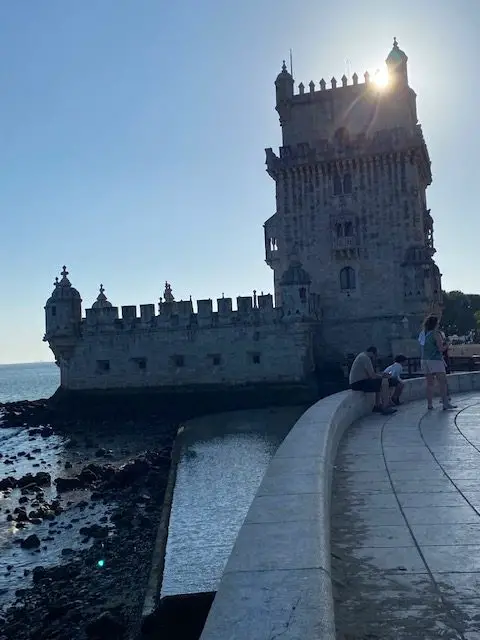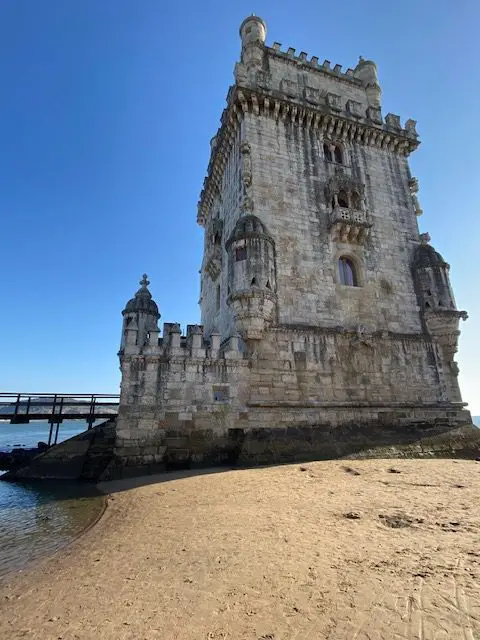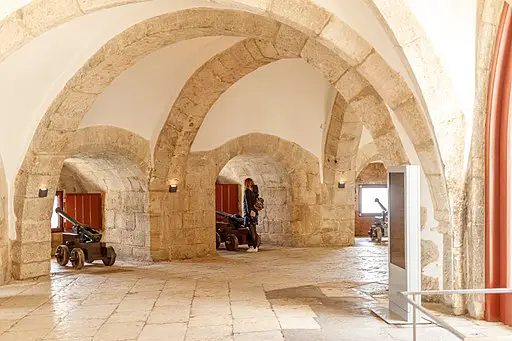The Tower of Belém has been standing guard over Lisbon since 1519.
For centuries, it has been the first and last thing that Portuguese sailors saw of their homeland.
Today it is an icon of Lisbon and the most widely-recognized landmark in Portugal.
If you will only be in Lisbon for one day, it is one of the stops on my Lisbon 24 hour checklist – what should I see and do?
The Belém Tower is just one part of Lisbon’s defensive network

The Tower of Belém (Torre de Belém) is officially named the Tower of St. Vincent in honor of Lisbon’s patron saint.
The fortress is one-third of a 16th-century defensive network built to protect the Lisbon harbor.
The other two components of this defense system are the Citadel of Cascais and the fortress of São Sebastião de Caparica.
Originally, there was a ship that defended the city and port of Lisbon, but King Manuel decided that it would be more efficient and more economical to build this third fortress rather than use a ship.
And why not? Vasco da Gama had just discovered a way to ship spices from India and Africa without relying on the Venetians.
Portugal became a leading importer of much-needed spices, and money was pouring into the treasury.
One of only a few remaining examples of Manueline architecture

The Belém Tower was built between 1514 and 1519. It is built out of the same lioz limestone that was used to build the Jerónimos Monastery across the street.
Typical of the Manueline style, the tower has very ornate details.
It is adorned with carvings of twisted rope, knots, navigational equipment, crosses of the Order of Christ (King Manuel was a member of this order), as well as natural elements.
If you look closely, you can see the head of a rhinoceros, which has eroded a bit over time.
This was a depiction of the first rhino seen in Europe – a gift to King Manuel.
The interior features rounded rib vaulted ceilings, another common feature of Manueline architecture.

Belém tower construction was overseen by master architect Francisco de Arruda
Arruda worked for a while in Morocco, and his tower also includes balconies and cupolas which can be seen in Muslim architecture.
He is one of the top architects of the period, having worked on some of Portugal’s other great sites, including the Amoreira aqueduct and the Church of Nossa Senhora da Assunçåo, as well as the Agua de Prata Aqueduct.
He also oversaw the construction of the Royal Palace of Évora.

King Manuel was known to use the tower to entertain.
The tower was also used as a political prison. This was unfortunate for the prisoners as the dungeons often filled with water.
The Belém Tower also served as a customs house for a while, taxing foreign ships as they pulled into the Lisbon harbor.
Even though the tower of Belém had 17 cannons, the Spanish navy overtook the tower in 1580 after a four-hour battle.
After this defeat, Phillip II of Spain became King of Portugal.
The two crowns were united for 60 years in what was called the Iberian Union.
Along with the Jerónimos Monastery, the Belém tower became a UNESCO world heritage site in 1983.
Address: Torre de Belém, Avenida Brasilia
GPS: 38.6916° N, 9.2160° W
T: 351 213 620 034
Official website: http://DGPC | Museums and Monuments | Museums and Monumentos of DGPC | Belém Tower (patrimoniocultural.gov.pt)
Belém Tower tickets
Normally admission is six euros. Children under 12 or admitted free, and seniors receive a 50% discount.
If you have a Lisboa card admission is free.
You can also buy a combination admission to the Jerónimos Monastery for €12, or a combination ticket to the Jerónimos Monastery and Ajuda Palace for €16.
Belém Tower operating hours
Hours: October to May 10 AM to 5:30 PM last admission 5 PM
Belem tower opening hours of May to September 10 AM to 6:30 PM last admission 5 PM. Closed on Mondays.
The tower is 59 feet wide. It is four stories and 98 feet tall. The four stories are connected by a narrow, spiral staircase of 120 steps.
The maximum capacity is 150 people, therefore lines to get in are often long.
Does the metro go to the Belém Tower?
There is no metro station in the Belém neighborhood. Nonetheless, there are several public transportation options.
How to get to the Tower of Belém?
Taxi or Uber takes roughly 20 minutes and €10 from downtown.
You could opt for bus 714 or 728, or you could take the train toward Cascais from Cais do Sodré train station, which takes about 10 minutes. Get off in Belém and walk west along the river.
Another option is the 15E tram, which takes 30 to 40 minutes. You can catch it at Praça da Figueira or Praça do Comércio.
Was the Belém Tower in Game of Thrones?
The Torre de Belém has not appeared in Game of Thrones.
What else is near the Belém Tower?
The Belém neighborhood holds several of Portugal’s national treasures.
A few hundred yards away is the Monument to the Discoveries (Padrão dos Descobrimentos) which was completed in 1958. Lisbon’s Monument to the Discoveries | Everything you need to know
Across the street from that is the Jerónimos Monastery, itself a UNESCO World Heritage Site, which was also commissioned in the early 1500s by Dom Manuel.

The western wing of the monastery also holds the National Museum of Archaeology http://National Museum of Archaeology (museunacionalarqueologia.gov.pt)
For more information on the Jerónimos Monastery, see my article, Is the Jerónimos Monastery worth visiting?
A little further east you will find the bakery where they make Pasteis de Nata https://pasteisdebelem.pt/en/. and the Museum of Art, Architecture and
Technology, Visit Lisbon’s Museum of Art, Architecture, and Technology (MAAT) as well as the popular National Coach Museum – one of the best carriage museums in the world.
For more information on Lisbon’s many museums, check out my article, Finding the most interesting museums in Lisbon
I am not associated with any of the businesses mentioned in this article.